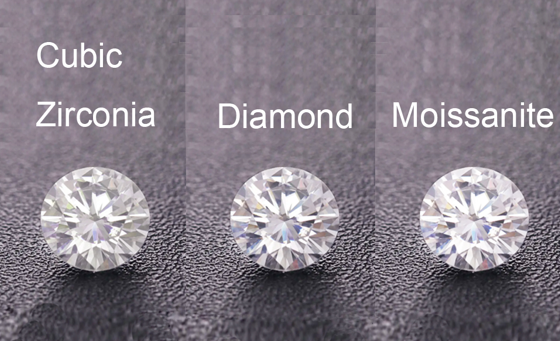Differences between diamonds, moissanite, cubic zirconia, zircon and rhinestones
Share

1. Diamond
• Natural or Lab-Grown: Can be mined (natural) or created in a lab (lab-grown).
• Hardness: 10 on the Mohs scale (hardest material known).
• Brilliance: High brilliance with strong white light reflection (“fire”).
• Durability: Extremely durable, scratch-resistant, and suitable for daily wear.
• Cost: Most expensive of all these options.
2. Moissanite
• Natural or Lab-Grown: Rare in nature; almost always lab-created.
• Hardness: 9.25 on the Mohs scale (second hardest gemstone).
• Brilliance: Higher dispersion than diamonds, meaning more rainbow-like flashes.
• Durability: Very durable, resistant to scratching and chipping.
• Cost: Much cheaper than diamonds but more expensive than cubic zirconia.
3. Cubic Zirconia (CZ)
• Natural or Lab-Grown: Always lab-created.
• Hardness: 8–8.5 on the Mohs scale.
• Brilliance: Has strong brilliance but less than moissanite and can appear glassy over time.
• Durability: Less durable than diamonds and moissanite; scratches more easily.
• Cost: Very inexpensive.
4. Zircon
• Natural or Lab-Grown: A natural gemstone.
• Hardness: 6–7.5 on the Mohs scale.
• Brilliance: High brilliance and fire, often mistaken for diamonds.
• Durability: Brittle and prone to chipping.
• Cost: Affordable but more expensive than cubic zirconia.
5. Rhinestones
• Natural or Lab-Grown: Usually glass, acrylic, or lead crystal.
• Hardness: 3–5 on the Mohs scale (very soft).
• Brilliance: Reflective but lacks the fire and depth of real gemstones.
• Durability: Easily scratched and not meant for long-term wear.
• Cost: Very cheap.
Summary
• Best for Durability & Value: Moissanite (if diamond is too expensive).
• Best for Affordability: Cubic zirconia (looks good but less durable).
• Best Natural Diamond Alternative: Zircon (but more fragile).
• Best for Costume Jewelry: Rhinestones (cheap and flashy).